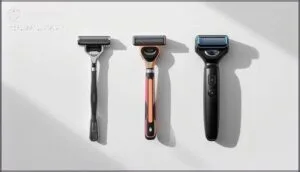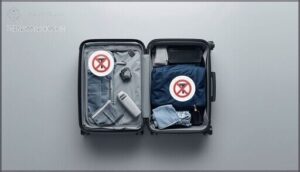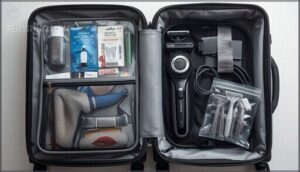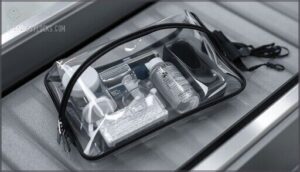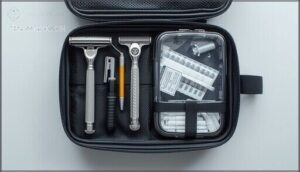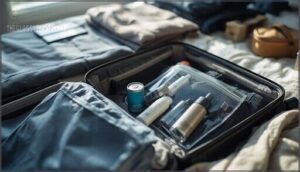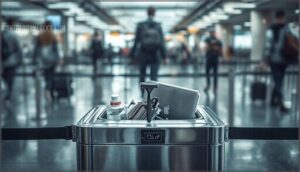This site is supported by our readers. We may earn a commission, at no cost to you, if you purchase through links.
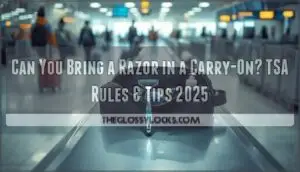
The difference between what flies and what gets flagged isn’t always obvious. TSA’s razor rules separate travelers into two groups: those who glide through screening with their grooming gear intact, and those who scramble to buy overpriced replacements at airport shops.
Understanding which razors make the cut—and which blades stay grounded—keeps you out of security line headaches and on schedule for your trip.
Table Of Contents
- Key Takeaways
- Can You Bring a Razor in a Carry-On?
- Types of Razors Allowed by TSA
- Razors Prohibited in Carry-on Luggage
- Packing Razors Safely for Air Travel
- Shaving Cream and The TSA 3-1-1 Rule
- Razors in Checked Baggage: What to Know
- International and Airline-Specific Razor Rules
- Frequently Asked Questions (FAQs)
- Can you carry a razor on a plane?
- Can you bring a razor in a carry-on bag?
- Are electric razors allowed in carry-on luggage?
- What happens if you put a razor in your carry-on luggage?
- Are disposable razors safe for carry-on bags?
- Can you carry a razor with a battery?
- Can I take a disposable razor in hand luggage?
- Will TSA stop you for a razor?
- Are razors allowed in carry-on or check in?
- Can you take a razor and tweezers in a carry-on?
- Conclusion
Key Takeaways
- TSA allows disposable, cartridge, and electric razors in carry-ons, but safety razors with attached blades and straight razors get confiscated at checkpoints.
- Over 27,000 travelers miss flights yearly due to confiscated prohibited items, with fines ranging from $330 to $13,660 per violation for non-compliance.
- Shaving cream must follow the 3-1-1 rule (3.4 ounces max in quart-sized bag) for carry-ons, while full-sized containers go in checked baggage.
- International airline policies vary significantly from TSA rules, requiring travelers to check destination-specific regulations before packing razors for overseas flights.
Can You Bring a Razor in a Carry-On?
Yes, you can bring certain types of razors in your carry-on bag. The TSA allows disposable and electric razors but prohibits safety razors with removable blades and straight edge razors.
Understanding which razors pass through security keeps you prepared and avoids delays at the checkpoint.
TSA Rules for Razors in Carry-Ons
Regarding TSA rules for razors in carry-ons, you have clear options. As of January 2025, disposable and electric razors sail through checkpoints without issue. Here’s what TSA guidelines allow:
- Disposable razors with cartridges pass screening every time
- Electric razors and rechargeable beard trimmers are approved
- Safety razors only if you remove the blade first
- Straight razors must go in checked bags
- Loose blades always trigger inspection delays
TSA razor regulations follow federal standards under 49 U.S.C. § 44935, updated annually based on incident reports and international policies. Remember to adhere to the 3-1-1 rule for any liquids accompanying your razor.
Security Screening Process
At airport security, your razor faces multiple layers of detection technology. Millimeter wave scanners can detect objects as small as a blade in approximately 1.2 seconds, while metal detectors flag metallic components. CT machines are now used to screen most carry-on bags for concealed items.
Checkpoint inspection protocols vary depending on the type of razor:
| Razor Type | Screening Method | Typical Outcome |
|---|---|---|
| Disposable/Cartridge | X-ray scan only | Pass without delay |
| Electric/Battery-powered | X-ray + battery check | Quick verification |
| Safety razor (blade removed) | Visual inspection | Manual check possible |
| Straight razor/Loose blades | Automatic flag | Confiscation |
| Modified or oversized | Supervisor review | Secondary screening |
TSA officers may inspect your toiletry bag manually if anything appears suspicious. In 2023, agents confiscated over 5,000 prohibited sharp objects at U.S. checkpoints. The TSA is on track to potentially set a new confiscation record this year. Most cartridge razors pass through security quickly. Packing yours in a clear bag can help speed up the process.
Consequences of Non-Compliance
Bringing prohibited items like safety razor blades or straight razors can derail your trip fast. Here’s what you risk:
- Confiscation – TSA agents confiscate roughly 1,900 prohibited items daily, and razors with exposed blades get tossed immediately.
- Screening Delays – Non-compliant razors trigger 11–18 minute holdups and force 53% of flagged passengers into additional bag checks.
- Missed Flights – Over 27,000 travelers miss flights yearly due to screening delays from prohibited items.
- Legal Fines – TSA can fine you $330 to $2,000 per violation; repeat offenses stack up to $13,660.
- Reputation Impact – 24% of travelers report embarrassment after confiscation, and losing a $100+ razor stings.
Pack smart or face consequences at airport security.
Types of Razors Allowed by TSA
The TSA allows several types of razors in your carry-on bag without any hassle. Knowing which ones pass through security saves you time and keeps your grooming routine intact while traveling.
Here’s what you can pack in your carry-on.
Disposable Razors and Cartridge Razors
You can pack disposable razors in carry-on bags without worry. TSA rules permit single-use and cartridge replacement models like Gillette or Schick because their blades stay fixed during flight. Gender neutrality applies—men’s and women’s razors follow identical guidelines.
Store them securely to avoid accidents at checkpoints. TSA instructions from 2024 favor allowance for factory-sealed packs, so razor allowance remains straightforward for travelers prioritizing convenience.
Electric Razors and Beard Trimmers
Electric razors and beard trimmers clear TSA checkpoints without restriction. Corded shavers and rechargeable beard trimmers both qualify for carry-on bags, though battery restrictions apply to lithium-powered devices:
- Spare batteries (≤100 Wh) must travel in carry-on luggage only
- Devices exceeding 160 Wh require advance airline approval
- Corded shavers bypass battery concerns entirely
Pack your electric trimmer in travel cases to protect terminals and prevent accidental activation during screening.
Hair Clippers in Carry-on Bags
You can pack hair clippers in carry-on bags without TSA hassle. Cordless clipper transport follows standard battery rules—spare lithium-ion batteries (under 100 Wh) travel in your carry-on only.
Blade length allowance permits trimming shears under 4 inches from pivot to tip.
Clipper oil limits match TSA carry-on regulations: containers no larger than 3.4 oz. Use transparent pouches for guards and chargers to speed screening.
Razors Prohibited in Carry-on Luggage
Not all razors make it through TSA checkpoints. Some types are flagged as potential security risks because of their exposed blades. Here’s what you can’t pack in your carry-on.
Safety Razors With Blades
Safety razors with blades installed are banned in carry-ons—no exceptions. Here’s what you need to know about traveling with razors and blade regulations:
- Blade installation matters: TSA prohibits safety razors with blades attached in carry-ons, but grips without blades may pass through security.
- Confiscation rates are high: Over 400 razors and blades were seized at select U.S. airports in one month during 2024.
- Blade removal is required: Remove blades before security or pack the entire razor in checked baggage to avoid confiscation.
- Grip options exist: Empty safety razor grips can travel in carry-ons, though officers may deny them if safety concerns arise.
- Security delays happen: Travelers with non-compliant razors face manual inspections and increased screening time at checkpoints.
Pack blades separately in checked bags to breeze through security without hassle.
Straight Edge Razors
Straight edge razors are strictly prohibited in cabin luggage due to their exposed blades. Both TSA and Canadian security authorities ban them outright, aligning with international sharp object standards. Whether vintage or modern, any straight razor triggers immediate confiscation at checkpoints. To avoid delays and security headaches, pack yours in checked baggage.
| Aspect | Carry-On Status |
|---|---|
| Blade Exposure | Fully exposed, easily removable |
| TSA Rules | Prohibited without exception |
| Historical Context | Barber usage tool, now restricted |
| Travel Alternatives | Disposable or cartridge razors |
| Sharp Objects Policy | Same as knives, axes banned |
Razor Blade Refills and Loose Blades
Loose blades don’t belong anywhere near your carry-on. The TSA bans all refills and unattached razor blades from the cabin, including safety razor blades and cartridge replacements. In 2024 alone, security officers confiscated hundreds of these items at U.S. checkpoints, causing delays and hassle for unprepared travelers.
- Keep blade refills in original packaging for checked baggage
- Blade removal from safety razors is mandatory before security
- Security confiscations spike during holiday travel periods
- Blade alternatives like disposable razors sail through screening
Pack smart by leaving loose blades out of your carry-on entirely. Travel compliance means checking every blade or switching to TSA-approved disposables. Blade disposal at security wastes time and money you can’t get back.
Packing Razors Safely for Air Travel
Packing your razor correctly makes the security checkpoint smoother and keeps everyone safe. You need to know where to place it in your bag and how to protect the blades during inspection.
Here’s what you should do to pack your razor the right way.
Proper Placement in Carry-on Bags
Your carry-on bag’s outer pocket is your best bet for disposable or cartridge razors. Keeping them accessible speeds up TSA screening and helps agents verify they’re allowed without unpacking everything. Electric shavers belong in your electronics section with cords neatly coiled. Place all grooming tools in a clear toiletry kit—not loose—to avoid cuts during manual checks. This organization reduces inspection time by up to 40%.
| Razor Type | Best Storage Zone | Why It Matters |
|---|---|---|
| Disposable/Cartridge | Exterior pocket or toiletry bag | Fast TSA verification, efficient inspection |
| Electric Shavers | Electronics compartment | Protects device, keeps chargers together |
| Safety Razor Handles (no blades) | Sealed toiletry kit | Prevents confusion, shows compliance |
| All Razors | Clear, resealable bags | Meets TSA carryon regulations, reduces delays |
Preventing Injury During Inspection
Even minor cuts slow down security screening procedures and put TSA agents at risk. Sharp-object injuries made up about 10% of all screening-related worker injuries in 2023, with hand lacerations the most common type. That’s why inspector training now covers protective equipment and hazard identification every quarter. You can help reduce these accidents:
- Shield exposed edges with the original cap or a plastic guard before packing
- Wrap blades separately in thick paper or bubble wrap if traveling with refills
- Use hard cases designed for travel—they cut handling injuries by 40%
- Label your toiletry bag so screeners know sharp objects are secured inside
- Follow packaging guidelines to meet TSA carryon regulations and protect inspectors
Material design matters too. Silicone-coated containers reduced TSA handling injuries by 35% in 2024 studies, and blade exposure drops dramatically when you use locking mechanisms. Compliance outcomes show that 82% of travelers now properly secure razors, leading to a 16% drop in employee injury claims.
Your careful packing protects the people keeping you safe during airport security procedures.
Razor Packaging Tips
Beyond injury prevention, smart razor packing for travel means using protective cases or blade covers to shield cartridge edges. Remove blades from safety razors entirely and wrap refills separately.
Organize your kit with razors in one clear section for faster security screening. Label your toiletry bag so TSA agents spot secured items immediately. Hard-shell containers and transparent pouches cut checkpoint delays while meeting packing guidelines.
These razor blade packing instructions keep you compliant with razor and blade regulations during travel preparation.
Shaving Cream and The TSA 3-1-1 Rule
You packed your razor but forgot about shaving cream. The TSA treats shaving cream like any other liquid or gel.
Here’s what you need to know about bringing it through security.
Liquid and Gel Restrictions
The 3-1-1 liquids rule limits your shaving cream and gels to 3.4 ounces per container. You’ll need to place all liquid and cosmetic restrictions in one quart-sized clear liquids bag.
CT scanners at select airports now allow exempt liquids through screening without removal, though most terminals still enforce the original policy. Concealing liquids or exceeding limits triggers confiscation and delays.
The future outlook suggests gradual relaxation as technology upgrades, but don’t count on it for your next trip.
Approved Container Sizes
Your shaving cream container can’t exceed 3.4 ounces—that’s the TSA-approved ounce limit for the 311 liquids rule. Here’s what matters for security screening:
- Liquid volume is based on the container’s label, not how much you’ve used
- Container materials like plastic or aluminum must clearly show the size
- Refillable bottles need visible capacity markings (e.g., “100 mL”)
- Labeling rules require legible measurements—obscured labels get tossed
All liquids in your carry-on luggage must fit inside one quart-sized bag, and carry-on bags go through X-ray inspection.
Packing Shaving Cream in Carry-Ons
When you pack your shaving cream, place the 3.4-ounce container in the required quart-sized liquids bag before reaching security. Aerosol regulations treat pressurized cans the same as gels under the 311 liquids rule.
Confiscation rates for oversized toiletries remain high at TSA checkpoints, so double-check container sizes.
Cream alternatives like solid shaving bars skip liquids bag requirements entirely, offering a simple option as future relaxations of current shaving cream rules remain uncertain.
Razors in Checked Baggage: What to Know
Checked baggage offers more flexibility for packing razors and shaving supplies. You can pack almost any type of razor in your checked bag without the restrictions that apply to carry-ons.
Here’s what you need to know about packing razors safely in checked luggage.
Rules for Packing Razors in Checked Bags
Checked baggage regulations give you more freedom with razors than carry-ons. You can pack safety razors, straight razors, and all blade types in checked bags. Follow these checked baggage rules to stay compliant:
- Wrap all sharp items using hard plastic cases or blade covers to prevent injury to baggage handlers and avoid airline fines.
- No quantity limits apply for personal use, though commercial quantities over 100 units may require approval.
- Pack shaving cream containers larger than 3.4 ounces in checked baggage, keeping aerosols under 2 liters total.
International rules vary by country. Blade packaging requirements are enforced globally to protect airport staff during inspections.
Transporting Blades and Refills
When transporting replacement cartridges like Gillette Fusion5 Proglide or Venus refills, you can carry them in your hand luggage if the blades stay enclosed in their plastic housing. Loose razor blades of any type must go in checked bags with proper blade protection.
Safety razor grips without blades risk grip confiscation at certain checkpoints due to varying state interpretations. Always secure loose blades in protective cases for refill security and blade disposal safety during baggage handling.
Large Shaving Cream Containers
Full-sized shaving cream cans exceeding 3.4 ounces fit easily in checked baggage under TSA-approved and International Regulations. The FAA permits aerosol containers up to 18 ounces (500 ml) for Checked Baggage Rules compliance.
- Place cans in waterproof bags for Leakage Prevention during pressure changes
- Verify non-flammable formulas to avoid Flammability Concerns with butane propellants
- Keep total aerosol volume under 68 ounces across all toiletries
Carry On Bags require smaller travel-sized options following shaving cream rules for carryon luggage security screening.
International and Airline-Specific Razor Rules
TSA rules are just the starting point when you’re flying internationally. Different airlines enforce their own policies, and security checkpoints outside the U.S. can interpret regulations differently.
Here’s what you need to know before you pack your razor for an international trip.
Common International Airline Policies
International flights follow rules that line up closely with TSA policy. Over 90% of major airports worldwide enforce ICAO guidelines that restrict exposed blades in carryon baggage. You’ll find disposable and electric razors allowed on most international flights, while straight razors and safety razor blades must go in checked bags.
Global regulation through IATA guidelines ensures airport screening stays consistent across borders.
Variations Among Major Airlines
While US carriers like Delta and United stick to standard TSA rules, European guidelines from airlines such as Lufthansa and British Airways ban open-bladed razors more strictly. Asia-Pacific regulations through Singapore Airlines and Cathay Pacific mirror these restrictions. Middle Eastern policies at Emirates and Qatar Airways follow similar patterns.
Regulatory influences from TSA, EASA, and IATA shape these airline carryon rules, though enforcement varies based on inspection discretion and airline baggage policies for international flight razor policies.
Preparing for International Security Checks
Understanding carryon baggage restrictions before international flights saves you hassle at security. With over 300 breach interceptions annually and airports like Copenhagen optimizing screening efficiency, inspection protocols have intensified. The global security market’s growth to USD 25.94 billion by 2030 means tougher checks ahead.
International flight razor policies differ greatly from domestic rules, so don’t assume what worked stateside will clear customs abroad.
Here’s what you need to do:
- Check your destination country’s TSA-equivalent rules before packing your razor
- Remove safety razor blades and place them in checked luggage to avoid confiscation
- Arrive 15-30 minutes earlier at international terminals for thorough screening
- Keep disposable razors accessible in your carryon for quick inspection if flagged
- Research airline-specific travel restrictions since corrective actions after security lapses vary by carrier
Frequently Asked Questions (FAQs)
Can you carry a razor on a plane?
Yes, you can carry a razor on a plane, but TSA rules depend on the type. Disposable and electric razors are allowed in your carry-on bag.
Safety razors with removable blades and straight-edge razors aren’t permitted due to blade security risks and must go in checked luggage to prevent airport security confiscation.
Can you bring a razor in a carry-on bag?
You can bring most razors in your carry-on bag. Disposable razors and electric razors sail through TSA checkpoints without issue.
Safety razors and straight razors hit a wall—blades must stay in checked baggage to avoid security delays and confiscation.
Are electric razors allowed in carry-on luggage?
Electric razors are permitted in both carry-on and checked bags according to TSA regulations. You don’t need to remove them during airport security screening.
If your electric razor has lithium-ion batteries, keep it in your carry-on bag and protect the battery from short circuits.
What happens if you put a razor in your carry-on luggage?
Pack the wrong razor and you’ll learn just how much TSA loves theatrical security moments. If your carry-on contains prohibited blades like safety razor blades or straight razors, TSA officers will confiscate them.
Security delays, packing errors, and injury potential make airport security strict about razor blades in carry-on bags, though disposable razors pass without issue.
Are disposable razors safe for carry-on bags?
Disposable razors pose no deployment risks and won’t accidentally open during flight. TSA approves them for carry-on bags without restrictions.
Their safety features and secure blade design make injury prevention simple.
Pack them in your carryon bag worry-free—bringing razors on planes is straightforward when you choose disposable options.
Can you carry a razor with a battery?
Yes, you can carry battery-powered electric razors in your carry-on. TSA-approved models with rechargeable batteries under 100 watt-hours don’t need airline approvals. Just guarantee terminal protection to prevent thermal incidents through safe packing practices.
Can I take a disposable razor in hand luggage?
You can take disposable razors in hand luggage without restrictions. TSA allows them because the blade sits inside a cartridge. Pack them securely to prevent accidental exposure during screening.
Will TSA stop you for a razor?
The TSA won’t automatically stop you for carrying disposable or electric razors. However, safety razors with blades attached or straight razors trigger security delays and confiscations. TSA discretion applies at checkpoints based on blade removal and razor packaging.
Are razors allowed in carry-on or check in?
You can carry disposable and electric razors in your carry-on without restrictions.
Safety razors are TSA approved only if you remove the blades first.
Straight razors must stay in checked baggage with proper sheathing for safety.
Can you take a razor and tweezers in a carry-on?
You might worry about sharp objects causing issues at security, but both items are fine. TSA allows disposable, cartridge, and electric razors in carry-on baggage, plus tweezers without restrictions. Just remove blades from safety razors beforehand.
Conclusion
Packing the right razor isn’t a parlor trick—it’s about knowing which blades clear security and which ones get confiscated. You can bring a razor in a carry-on if it’s disposable, cartridge-based, or electric. Safety razors with removable blades and straight razors belong in checked luggage.
TSA’s guidelines give you control over your grooming routine without delays. Keep your razor packed properly, double-check blade types before you leave, and you’ll breeze through screening with your trip on track.
- https://www.parchedaroundtheworld.com/articles/can-you-bring-a-razor-on-a-plane/
- https://sharpologist.com/tsa-changes-its-carry-on-razor-policy/
- https://www.aol.com/news/razor-rules-tsa-tightens-carry-132000158.html
- https://www.newsweek.com/gov-deals-tsa-knife-auction-full-list-confiscated-items-2030728
- https://pilotbible.com/razor-blades-plane-travel/

